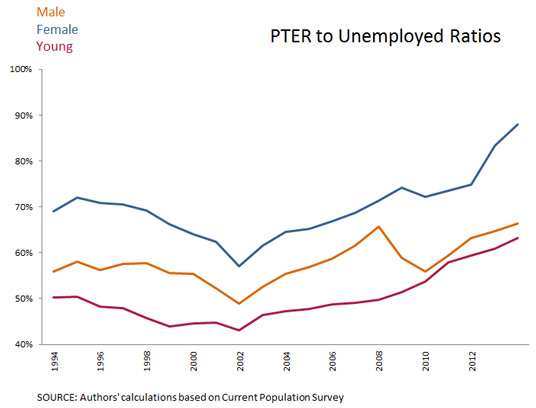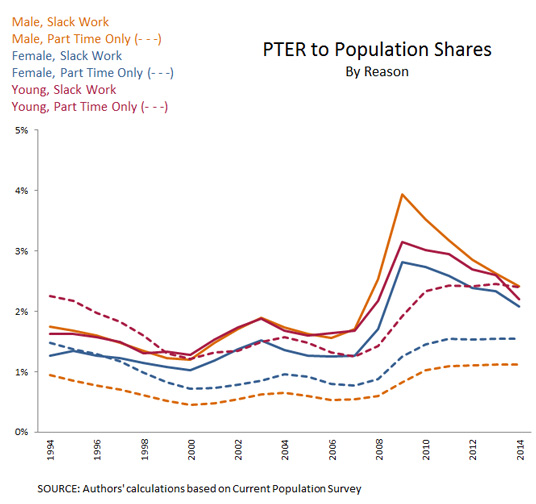Part-Time Worker Levels Remain a Concern
Workers working part time for economic reasons (PTER)1 have been examined as a measure of labor underutilization. One of the recent concerns is that while the number of unemployed individuals and marginally attached individuals2 has been decreasing since 2009, the number of individuals who are working PTER has remained elevated (almost 7.5 million workers in April 2014).
In a recent joint article with Marianna Kudlyak and Marisa Reed, both with the Federal Reserve Bank of Richmond, we found that indeed the ratio of individuals working PTER to unemployed workers has been higher during the Great Recession than in the 2001 recession. The dynamics however have not been different: The ratio increases at the business cycle trough and reaches its highest point at the business cycle peak.
However, the dynamics of the ratio of individuals working PTER to unemployed have not followed a common pattern across all demographic groups. Breaking the data by age groups, we find that the ratio of young workers (ages 16-24) working PTER to unemployed increased significantly from 1994 to 2014, from 50 percent to 62.3 percent. Similarly, the ratio of female workers working PTER to unemployed increased almost 19 percentage points between 1994 and 2014. While the ratio of men working PTER to unemployed decreased 10 percentage points between 2008 and 2010, that ratio was relatively constant for women.

Differences are also observed in the composition of individuals working PTER in those groups. Reasons people in this group are working part time include slack work or because only a part-time job could be found. Among young workers working PTER, the share of the population citing that it can find only part-time work is almost the same as that citing slack work/business conditions. Both reasons spiked in 2009, while for males only slack work/business conditions spiked in 2009.
Gender differences are also observed across reasons. Female workers cited that they can find only part-time work at a higher frequency than men did. The ratio of women citing that they can find only part-time work reached 1.45 percent in 2010 (almost 1.5 million females), while it was only 1.02 percent for men (representing 1 million male workers).

These different dynamics are the result of various factors:
- While the number of males working PTER increased by 1.6 million individuals between 2008 and 2009, the number of male unemployed individuals increased by 3.3 million. Meanwhile, 0.5 million more young workers reported that they were working PTER between 2008 and 2009, but only 0.9 million more reported being unemployed. Similarly, the growth of females working PTER grew faster than the growth of females who were unemployed between these years.
- The slower increase in unemployment of women and young workers relative to men is also a consequence of the secular downward trend in the labor force participation (LFP) of young workers and women since 2000, while the LFP trend of males has not decreased significantly.
Notes and References
1 Workers working part time for economic reasons are employed and working less than 35 hours per week, but would like to work full time.
2 Marginally attached individuals are workers who are not in the labor force, who want and are available for work and who have looked for a job in the past 12 months but not in the four weeks prior to the survey being conducted.
Additional Resources
- Regional Economist: Is Involuntary Part-time Employment Different after the Great Recession?
- On the Economy: What Private Payroll Employment Numbers Say about the Labor Market
- On the Economy: The Effects of Extending Unemployment Insurance Benefits
Citation
Maria E Canon, ldquoPart-Time Worker Levels Remain a Concern,rdquo St. Louis Fed On the Economy, Aug. 11, 2014.
This blog offers commentary, analysis and data from our economists and experts. Views expressed are not necessarily those of the St. Louis Fed or Federal Reserve System.
Email Us
All other blog-related questions

